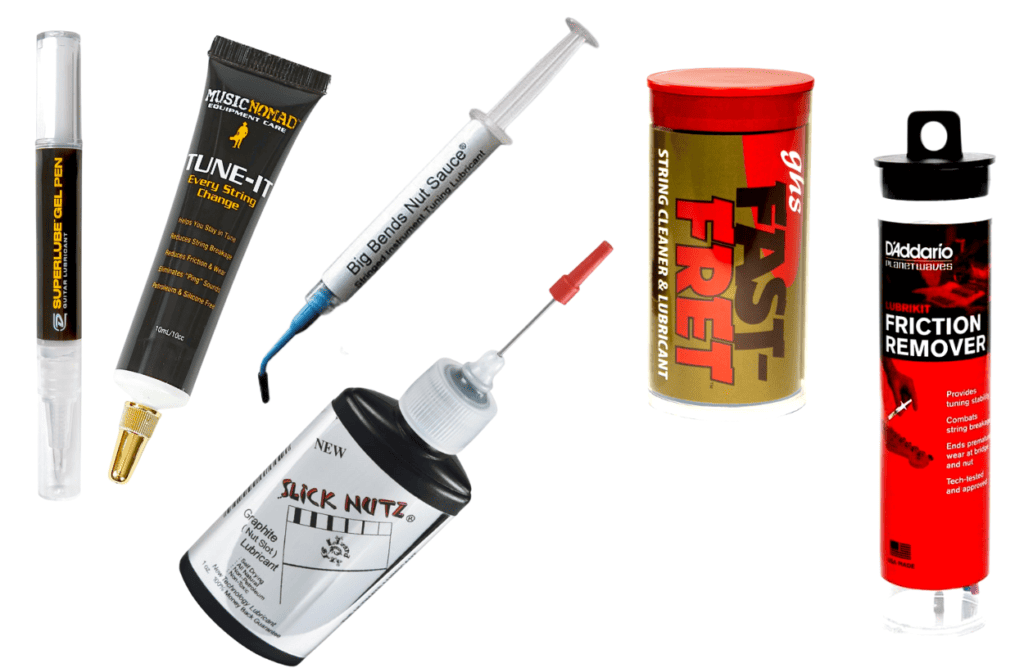Have you ever been in the middle of a jam session, and suddenly a string breaks? Or perhaps you’ve battled with keeping your guitar in tune during a performance? If these scenarios sound familiar, you might want to learn about guitar nut lubricants.
These handy little helpers can play a big role in preventing string breakage and ensuring your instrument stays in tune, offering a smoother playing experience.
In this guide, we will explore the what, why, and how of guitar nut lubricants and introduce you to some of the best available options. We’ll also learn about two great alternatives to nut lubricants at the end of the article.
Let’s dive in and discover how this small step in maintenance can make a big difference in your playing, or click here to go directly to the best nut lubricates list.

Table of Contents
What’s a Nut Lubricant?
A nut lubricant is a specialized product designed specifically for the guitar’s nut, that small piece of bone, plastic, or metal located at the top of the fretboard where the strings rest.
The main function of the nut is to elevate the strings off the neck and guide them to the tuners, maintaining the correct spacing and ensuring proper string height.
Nut lubricants are formulated to reduce friction between the strings and the nut slots. When a guitar string vibrates, it needs to move freely over the nut without any sticking points.
A nut that isn’t properly lubricated can cause the string to bind or pinch, leading to various playability and tuning issues.
A good nut lubricant generally comes in the form of a gel, paste, or liquid, and its composition may include elements like graphite, Teflon, or synthetic compounds.
These ingredients help to create a slippery surface, allowing strings to glide over the nut with ease, ensuring smooth bends, accurate tuning, and extended string life.
Why Do You Need a Nut Lubricant?
The nut is a critical part of the guitar’s anatomy, subtly influencing both playability and tone.
While it may seem like a static, non-essential piece, the interactions between the strings and the nut significantly affect your guitar-playing experience.
But why exactly should you consider using a nut lubricant? Let’s dive into the specific reasons.
Tuning Stability
Have you ever noticed your guitar going out of tune more often than it should, especially after using the vibrato bar or performing a bend? The nut might be a major culprit. When you bend a string or use the whammy bar, the string moves through the nut.
If the nut slots are not smooth or have friction points, the string might not return to its original position, leading to tuning instability. Nut lubricants provide a slick surface, ensuring that strings slide back into place, maintaining precise tuning after vigorous playing.
Break Fewer Strings
We all know the frustration of a string snapping during a jam session or performance. While strings can break due to age or defects, another common cause is friction at the nut.
When a string is tuned or bent, it slides through the nut slot. If the slot is too tight or has friction, the stress on the string increases, elevating the risk of breakage.
A lubricated nut minimizes this friction, reducing the likelihood of string breakage and ensuring you stay in the groove without unwelcome interruptions.
Better Sounding Bends
When you bend a string, its tension increases, moving through the nut slot. If the string sticks in the slot, it can produce unwanted noises or an inconsistent bend pitch.
Lubricating the nut enables the string to glide smoothly, ensuring your bends sound clean, precise, and musically satisfying.
Now, let’s explore some of the best nut lubricants available in the market to ensure your guitar performs at its best.
Best Nut Lubricants
By now, you probably understand the importance of a properly lubricated nut, and here are my favorite nut lubricants.
Their cost vary between $9 and $17, but they all essentially do the same thing and last for a really long time. Either one you choose will work and will be one of the most important guitar accessories you have.

1. D’Addario’s Planet Waves LubriKit
LubriKit provides a barrier against friction and wear by offering an easy application process with a syringe. It’s particularly effective for guitars with locking tremolo systems.
D’Addario LubriKit costs around $10.99 on Amazon, and you can check it out here.
2. Music Nomad MN106 TUNE-IT Lubricant
With its special formula, TUNE-IT minimizes friction between the strings and nut. It’s biodegradable, safe for all instrument finishes, and offers a smooth tuning process.
Music Nomand Tune-It costs about $10, and you can get it here on Amazon.
3. GHS Fast Fret
Though primarily a string cleaner, GHS Fast Fret doubles as a nut lubricant. It’s perfect for those who want to maintain their strings and nut simultaneously.
You can buy GHS Fast Fret from Amazon for about $9.6
4. Dunlop 6567 Superlube Gel Pen
Dunlop’s “Superlube” Gel Pen offers precise application with its nifty pen-like applicator. It ensures the strings slide smoothly in the nut slots, improving tuning stability and minimizing string breakage.
It’s relatively expensive compared to other products in this list, but it has the coolest name in the whole category.
Check out Dunlops’ Superlube on Amazon, it costs around $15.
5. Big Bends Nut Sauce
Renowned among guitarists, Big Bends Nut Sauce ensures that the strings move freely, enhancing tuning stability and reducing string breakage. It’s easy to apply and lasts for several string changes.
At about $17, this is the most expensive product in the list. You can check it here on Amazon.
6. Lizard Spit Slick Nutz (SLN10)
Lizard Spit Slick Nutz is formulated with a specific mission to drastically reduce friction at the guitar’s nut and bridge. This non-toxic, non-staining lubricant is revered for its proficiency in ensuring strings glide smoothly across the nut, preventing wear and enhancing tuning stability.
It costs about $15 on Amazon, and you can check it out here.
How to Use a Nut Lubricant
Applying a nut lubricant is very simple, so here’s a straightforward guide on how to go about it.
Pro Tip: Even though it’s called a nut lubricant, it’s as effective on the saddles as it is on the nut, so make sure to put some over there, too.
Step 1: Lower the Tension on the Strings
First things first, you need to lower the tension on the strings to gain unobstructed access to the nut. You can do this by detuning your guitar or removing the strings if you’re already planning on changing them.
Either way, the idea is to allow the lubricant to make thorough contact with the nut slots without the strings in the way.
Step 2: Apply Some Lubricant in the Nut Slots (Don’t Overdo It)
Now that your strings are loosened or removed, gently apply the nut lubricant to the slots. Be mindful here; a little goes a long way!
Gently dab or draw the lubricant across each slot, ensuring you get even coverage. Be cautious about applying only a little, as excess lubricant does not provide extra benefit and can create a mess.
Depending on the type of lubricant you’re using (liquid, paste, or pencil), the application method may vary slightly. Always follow the instructions provided with your chosen lubricant.
Step 3: Repeat Every 1-2 String Changes
Regular maintenance is key to preserving your guitar’s performance. Make a habit of applying the nut lubricant at regular intervals to sustain optimal functionality.
Typically, every 1-2 string changes or whenever you notice issues with tuning stability or string movement should suffice.
Consistent care in this manner will lead to fewer instances of string breakage and ensure your guitar consistently delivers peak performance.
Nut Lubricant Alternatives
If you understand the importance of using it, but still don’t want to buy a nut lubricant, there are two thing you can use instead.
Graphite From a Pencil
You read right. You can use a number 2 pencil to lubricate your nut. It’s not as good as any of the nut lubricants I mentioned, but it’s a lot better than not using anything.
I’ve also mentioned it in my article about tuning stability.

Self Lubricating Nut
Some materials used for making guitar nuts have a unique self-lubrication property. A famous one is Tusq by Graph Tech. It comes in some higher-end guitars, but you can also buy it separately and install it yourself pretty easily.
Finishing Thoughts
Nut lubricants might seem like a minor aspect of guitar maintenance, but their impact on playability and instrument longevity is undeniable.
A little attention to the nut can ensure your guitar sounds its best, stays in tune, and remains a joy to play.
Whether you’re a touring musician or a bedroom guitarist, consider nut lubrication an essential part of your guitar care routine.